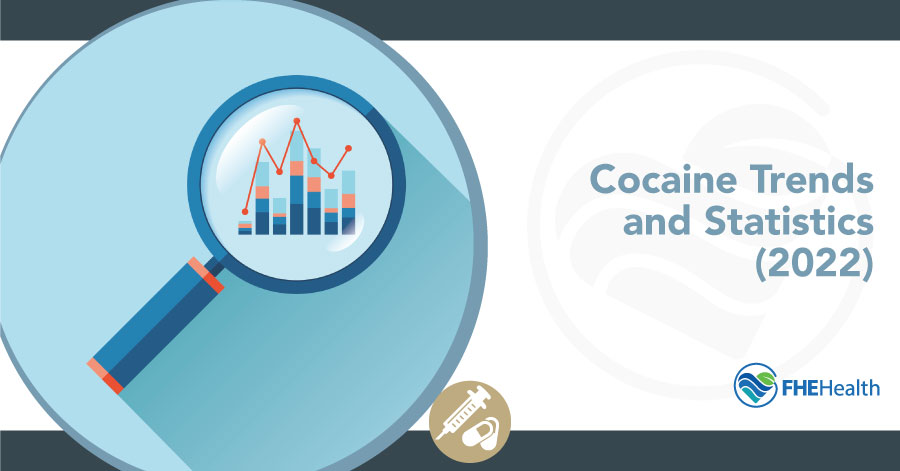
Cocaine is a powerful and highly addictive substance that comes from the leaves of the South American coca plant. While it has limited medical use in the United States, it’s one of the most popular recreational drugs for the intense high it produces. Unfortunately, it’s also one of the more dangerous recreational substances, leading to significant health risks such as heart and lung issues, seizures and overdose deaths.
By understanding the trends and statistics, we can support healthy communities and promote access to help for those living with an addiction.
Historical Context
While we largely associate cocaine with present-day use, it has a history that stretches back thousands of years. However, its potency and reasons for use have changed considerably over time, as have the laws governing it.
Origin and Early Use
The ancient Incas were the first known people group to cultivate the coca plant. As far back as 3000 BC, these inhabitants of the Andres would chew on the leaves of the plant to counteract the effects of high elevation. We see similar later use among Native Peruvians in the 1500s, who would chew on the leaves of the coca plant in religious ceremonies for its hallucinatory properties.
It wasn’t until the mid-1800s that cocaine was isolated from the coca leaves. In 1859, German chemist Albert Niemann extracted cocaine from the leaves. The drug wasn’t used medicinally until around 1884 when Sigmund Freud used the drug on himself and realized that it was a possible cure for depression. Around that time, John Pemberton, the maker of Coca-Cola, used the coca plant as the main ingredient of his soft drink. Coca-Cola became known for its euphoric effects, and it became very popular well into the turn of the century.
Legal Changes Over Time
In the United States, the legal status of cocaine has evolved significantly. Despite how widely used it was in the 19th century, the Harrison Narcotics Act of 1914 regulated and taxed its production, importation and distribution. In the Controlled Substances Act of 1970, it became classified as a Schedule II drug, meaning that it has medicinal purposes but is recognized for its high potential for misuse.
Further restrictions came through the Anti-Drug Abuse Act of 1986, which introduced severe penalties for those who used cocaine in its solid form but maintained much lighter sentences for those who used it in powder form. Because this law had a disproportionate impact on Black communities, there’s been a push in recent decades for equal sentencing for those who use cocaine in either form.
Current Global Trends
Cocaine remains one of the most commonly used recreational drugs nationwide, with production climbing to all-time highs in the 21st century.
Prevalence of Use
Recent data indicates around 22 million cocaine users nationwide, with about 0.5 percent of people having used the drug in the previous year. Africa and the Americas see the highest number of users, followed by Europe, Asia and lastly, Oceania.
Geographic Distribution
While cocaine use is present in all regions of the world, with over 90 percent of countries having seized the drug since 2019, North America ranks as the largest cocaine market. However, according to the United Nations World Drug Report 2024, the cocaine market in the United States appears to be contracting while use in Western, Central and South-Eastern Europe is expanding.
Additionally, Africa has increasingly become a key transit area for cocaine trafficking from Latin America to Europe. As a result, more people in West and North Africa are using the drug and seeking addiction treatment.
Production and Supply
While the global demand for cocaine has risen in recent years, production tends to be limited to the same countries that have always cultivated it. This has had an impact on agriculture as well as local economies.
Coca Cultivation
About two-thirds of the world’s cocaine supply comes out of Colombia. Peru ranks as the second largest producer, with around 95,000 hectares of coca cultivation, while Bolivia comes in third at around 30,000 hectares.
Aside from contributing to a global epidemic, the cultivation of coca has had a devastating impact on the communities producing it. Deforestation and soil and water contamination affect local wildlife, while the conversion of food crops to coca crops has jeopardized food security. Additionally, many regions become economically dependent on coca production, and their economies collapse when production is halted.
Trafficking Routes
Cocaine trafficking flows mainly from the Andean region to other countries in North and South America and to Western and Central Europe. While Central America has seen a reduction in trafficking due to government crackdowns on drug gangs, other key entry points have emerged, including North Sea ports in Europe. Eastern and South-Eastern Europe have also become major transit areas in recent years.
The UNODC World Drug Report notes several methods used for cocaine smuggling. For large shipments, container ships are often used to move cocaine across oceans, while commercial and private flights are used for quicker transport. Cartels may also use vehicles to move drugs over land routes, often mixing them in with legitimate goods. Finally, some regions have underground tunnels where smugglers move drugs under border lines.
Consumption Patterns
The UNODC World Drug Report also provides some important insight into the demographics of those who use cocaine.
User Demographics
In general, cocaine use is most prevalent among those aged 18-35. However, the report observed use among people of all ages, including seniors. Men made up about 70 percent of cocaine users. Overall, because cocaine tends to be a more expensive drug, it’s more common among people with high disposable incomes. However, it’s also present in lower-income groups, especially in urban areas.
Methods of Use
The most common methods of cocaine use include:
- Snorting: The cocaine powder is inhaled through the nose. Snorting cocaine is the most popular choice for users. When taken this way, the drug acts quickly on the brain and produces an intense rush in just a few seconds. The effect is short-lived, however, and a person using the drug may experience withdrawal within minutes or hours.
- Injecting: The cocaine powder is dissolved in water and injected directly into the bloodstream. Injecting cocaine has many of the same health risks as injecting heroin, such as collapsed veins and the transmission of bloodborne disease. IV cocaine use is one of the more hazardous ways to use the drug, and it accounts for a disproportionate share of overdose-related emergency room admissions.
- Smoking: The drug is reduced to its freebase form and smoked. When the pure form is smoked, or “freebased,” the near-instantaneous high hits hard and produces intense euphoria that can last half an hour or so before wearing off.
Swallowing cocaine is relatively rare since this is the least effective way to get the drug into the bloodstream. As a rule, swallowing cocaine is done as a reinforcement for a prior dose or to prolong the euphoria the drug produces. “Boosting” in this way can be dangerous since it increases the concentration of cocaine in the user’s system in unpredictable ways.
Health Impacts
Due to its potency, cocaine is highly addictive and harmful to the brain and body. Along with its wide range of long-term consequences, the drug has a variety of potentially dangerous short-term effects.
Short-Term Effects
Some initial side effects of cocaine include:
- An increase in body temperature
- High blood pressure
- An increase in heart rate
- Feelings of anxiety and paranoia
- Stomach upset
- Psychotic symptoms, including hallucinations and delusions
Long-Term Consequences
Cocaine’s long-term effects include:
- Stimulant use disorder
- Cardiovascular problems, including an increased risk of stroke
- Mental health issues such as anxiety and depression
- Weight loss
- Cognitive decline
- Organ damage
Legal and Societal Responses
The devastation of cocaine production, trafficking and use has created the need for policies and crackdowns. Additionally, as more people have recognized the dangers of cocaine use, public perception of the drug has shifted.
Law Enforcement Strategies
To cut down on the amount of cocaine coming into the United States, there have been several policies put into place. These include:
- Establishing the U.S. Council on Transnational Organized Crime and expanding the federal government’s ability to use sanctions to target drug trafficking organizations
- Releasing an updated Overdose Prevention Strategy that puts resources toward researching substance addiction, funding community-level initiatives and increasing access to safe pain management options
- Releasing the comprehensive National Drug Control Strategy, which focuses on preventing drug use, expanding access to addiction treatment and reducing the supply of illicit substances such as cocaine
Public Perception and Stigma
Cocaine use has often been seen as a status symbol, with its popularity among high-income users making it seem like a safe option. However, there’s been an increase in awareness of its dangers and lasting impact on physical and mental health. While use is still prevalent, especially among young adults, there’s been an increase in the demand for addiction treatment among those who use cocaine.
The Scope of a Cocaine Problem
Cocaine is an addictive drug, and the toll it takes is expensive. A heavy cocaine user can buy a gram a day and spend close to $50,000 a year on their habit. It’s estimated that something like 1.0 million people are dealing with cocaine use disorder, which is the medical term for cocaine addiction. Annually, these users go to the hospital more than 350,000 times and account for 54 percent of drug-related incarcerations in federal jails and prisons.
The cost of cocaine use in time, money, and freedom is high, but the death toll is also a major issue. Cocaine is either suspected or confirmed as the cause of nearly 16,000 overdose deaths in the United States each year. It’s at least a contributing factor in many more deaths, usually from violence, associated medical conditions, or other health impacts of the user’s lifestyle.
Conclusion
Cocaine use is one of the most widely used drugs worldwide, with North America seeing the highest number of users. While this drug certainly isn’t new – it’s been used for thousands of years – the way it’s processed has greatly increased its potency and potential for misuse. Its production and distribution have devastated communities, causing upticks in violent crime and drug-related health problems. Fortunately, the U.S. government has put several policies in place in recent years that support research, reducing access to cocaine and promoting addiction treatment options.
If you or someone you know is living with cocaine addiction, we’re here to help. Contact us for more information on our addiction treatment program.






